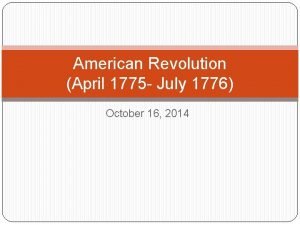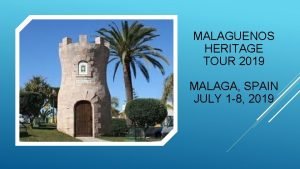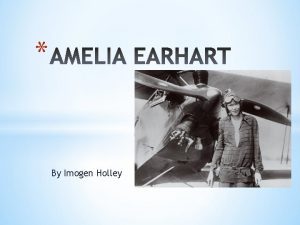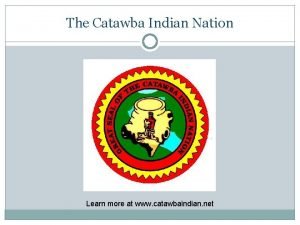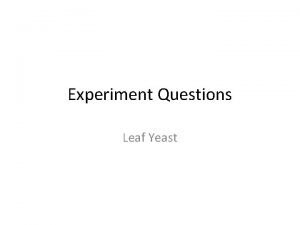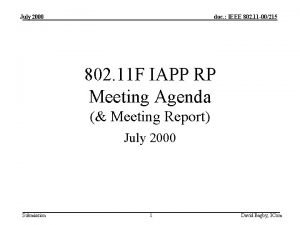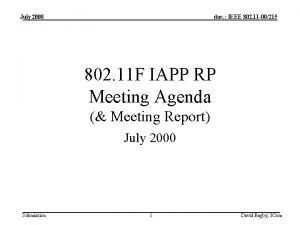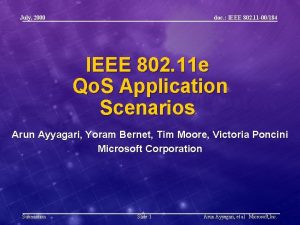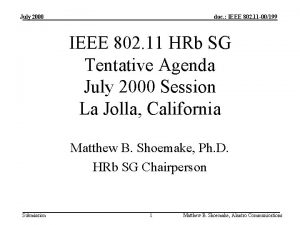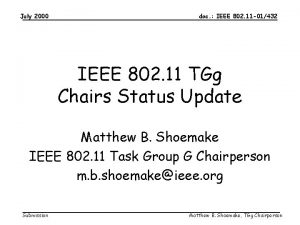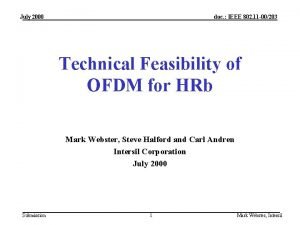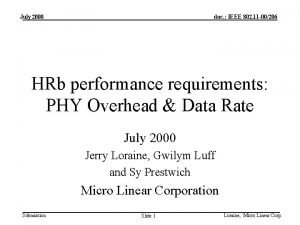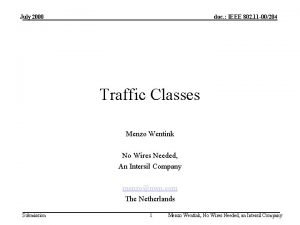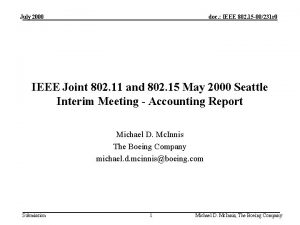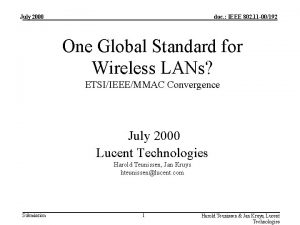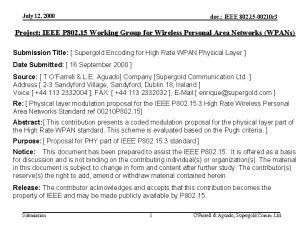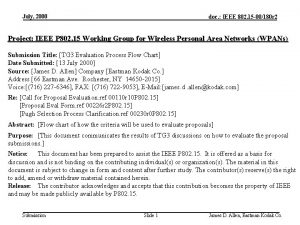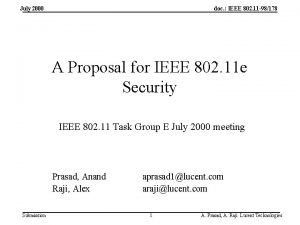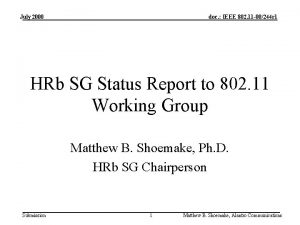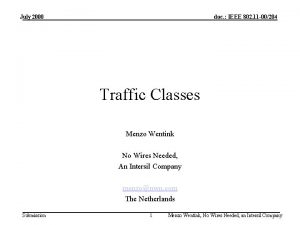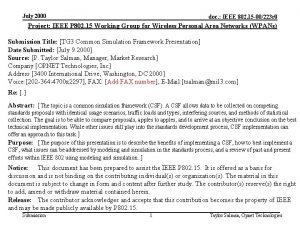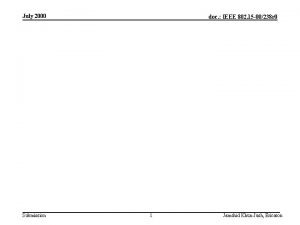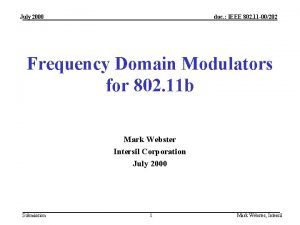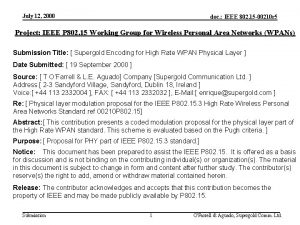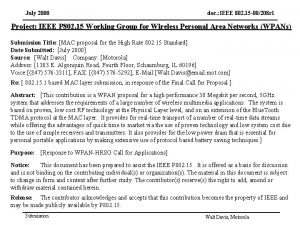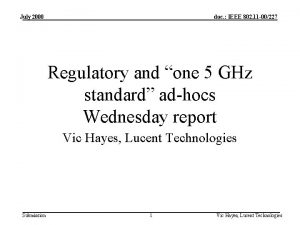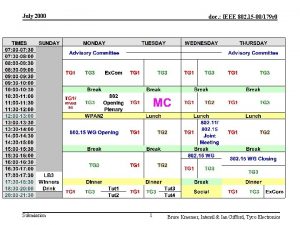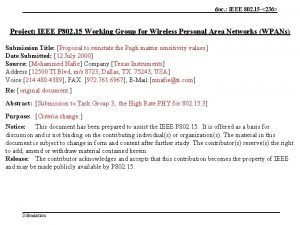July 11 2000 doc IEEE 802 15 00221



































- Slides: 35

July 11, 2000 doc. : IEEE 802. 15 -00/221 Berkeley Wireless Research Center An Overview July 11, 2000 http: //bwrc. eecs. berkeley. edu/bwrc Submission Slide 1 Gary Kelson, Berkeley Wireless Research Center

July 11, 2000 doc. : IEEE 802. 15 -00/221 r 0 BWRC –Mission Statement Provide an environment for research into the design issues necessary to support future wireless communication systems. The focus will be on highly integrated CMOS implementations which have the lowest possible energy consumption and lowest cost while using advanced communication algorithms. The evaluation of these components will be made in a realistic test environment. Submission 2 Gary Kelson, Berkeley Wireless Research Center

July 11, 2000 doc. : IEEE 802. 15 -00/221 r 0 The Design Goal: System on a Chip CMOS Radio Four Basic Components Configurable and Dedicated Logic Accelerators (bit level) Logic A D Timing recovery Equalizers Analog RF Filters analog digital u. C Core (ARM/Tensilica) phone Java book VM Keypad, Display Control ARQ MUD Adaptive Antenna Algorithms Direct Mapped Logic & DSP cores Submission 3 Gary Kelson, Berkeley Wireless Research Center

July 11, 2000 doc. : IEEE 802. 15 -00/221 r 0 BWRC Faculty Comm Engineering & Protocols David Tse Alberto S-V K. Ramchandran Jan Rabaey Bob Brodersen Bora Nikolic Paul Gray Bob Meyer Paul Wright Chenming Hu Submission Radio Architecture Analog & Digital Circuits Technology 4 Gary Kelson, Berkeley Wireless Research Center

July 11, 2000 doc. : IEEE 802. 15 -00/221 r 0 Center Industrial Members • • Cadence Design Systems Ericsson Radio Systems Agilent Technologies Lucent Technologies STMicroelectronics Texas Instruments Intel Corporation Submission 5 Gary Kelson, Berkeley Wireless Research Center

July 11, 2000 doc. : IEEE 802. 15 -00/221 r 0 BWRC Funding • Operating Budget: $3. 5 M/yr • Infrastructure: $600 - 800 K/yr – Member companies • Research: $2. 0 - 2. 5 M/yr – Member companies – DARPA programs • Low power Pico. Radio Networks • Mixed signal CAD for single chip-radios – Office of Naval Research (ONR) • Ultra-Wideband Radios – Pending • • Submission DARPA: Defense Advanced Research Projects Agency NSF: National Science Foundation DOE: Department of Energy ONR: Office of Naval Research 6 Gary Kelson, Berkeley Wireless Research Center

July 11, 2000 doc. : IEEE 802. 15 -00/221 r 0 Intellectual Property • Aggressively publish research results • The center will pursue an active policy of placing research results in the public domain as determined by the Center Scientific Directors • Non-member companies have access to the public domain results, but do not directly participate in center research Submission 7 Gary Kelson, Berkeley Wireless Research Center

July 11, 2000 doc. : IEEE 802. 15 -00/221 r 0 Facilities • Very Effective Hub for Wireless Research – Excellent and efficient working environment • Cubicle usage at capacity – Virtual user mode – Online reservation system – Wireless laptops for overflow Submission 8 Gary Kelson, Berkeley Wireless Research Center

July 11, 2000 doc. : IEEE 802. 15 -00/221 r 0 Facilities Continued • Laboratory – Capabilities; Complete chip and system level testing • • • RF Digital Analog Networked Instruments Laptop Controllers – Installed Cascade semi-automatic probe station, 40 GHz wafer/die level probing – Lab capital expansion ~ $100 -200 K/yr minus donations Submission 9 Gary Kelson, Berkeley Wireless Research Center

July 11, 2000 doc. : IEEE 802. 15 -00/221 r 0 Computer System • Design Tools – Windows NT Desktop (~50 clients) with Unix Compute Servers (X Windows), – GB fiber network back-plane • 3 NT Servers • 6 Unix Servers – Network Appliance filer, 450 GB – DS 3 fiber link to campus with T 1 backup – Spectra. Logic tape backup – Lucent Wave. Lan for Laptops – Migrating to Windows 2000 Submission 10 – – – – Cadence Synopsys Mentor Viewlogic HSPICE EESoft ADS Telelogic The Math. Works Tensilica Sonics Opnet Cygnus RTOS Sente Gary Kelson, Berkeley Wireless Research Center

July 11, 2000 doc. : IEEE 802. 15 -00/221 r 0 BWRC Focal Areas Comm. Algorithms Signal Processing Protocols Networking Spectrum Sharing Pico. Radio Design Methodology Platforms Architectures Circuit Fabrics Submission 11 Gary Kelson, Berkeley Wireless Research Center

July 11, 2000 doc. : IEEE 802. 15 -00/221 r 0 Spectrum Sharing • The goal is to determine a flexible way to utilize spectra which can adapt to new technology and applications with maximum capacity and minimum interference – TFS Algorithm development – Ultra Wideband (UWB) – 802. 15 • Bluetooth/WLAN Coexistence Submission 12 Gary Kelson, Berkeley Wireless Research Center

July 11, 2000 doc. : IEEE 802. 15 -00/221 r 0 TFS approach • Three “types” of dimensionality in signal space – Frequency – Time – Physical Space • Exploit all these degrees of freedom to maximize the number of users and to minimize their interference with each other • Understand complexity issues and implementation strategies Submission 13 Gary Kelson, Berkeley Wireless Research Center

July 11, 2000 doc. : IEEE 802. 15 -00/221 r 0 Once upon a time. . . • Feb 1999 – BWRC opens for business, with the Universal Radio (UR) listed as one of 3 design drivers. – An ambitious radio design that allows for uncoordinated co-existence with other radios. – Adapts to provide requested service given type of service, location, and dynamic variations in environment (i. e. number of users). – Allows for continuous upgrades to support new services as well as advances in communication engineering and implementation technologies. Submission 14 Gary Kelson, Berkeley Wireless Research Center

July 11, 2000 doc. : IEEE 802. 15 -00/221 r 0 The USS era • June 1999 – Spectrum sharing is identified as the key challenge for the UR. – UR driver evolves from a radio design into a spectrum management initiative, and is renamed "Universal Spectrum Sharing" (USS). – USS study group is formed to investigate strategy for uncoordinated use of spectra without loss in capacity. – Simultaneously exploit time, frequency, space. – Main goal: change the way spectrum is allocated. Submission 15 Gary Kelson, Berkeley Wireless Research Center

July 11, 2000 doc. : IEEE 802. 15 -00/221 r 0 USS Guidelines • Fall, 1999 – Several guidelines proposed for spectrum sharing: • Use transmit power as a constraint which encourages good behavior • Good behavior means: – localization in temporal-frequency-spatial signal space which allows other users to coexist without interference – stationary or predictable behavior which facilitates adaptation by other users – alignment to a time and frequency structure which facilitates co-existence Submission 16 Gary Kelson, Berkeley Wireless Research Center

July 11, 2000 doc. : IEEE 802. 15 -00/221 r 0 USS difficulties • Jan, 2000 – We had no rigorous results for the difficult problem of spectrum sharing -- we only had guidelines. – This may stem from lack of results in information theory. The interference channel has not yet been “solved" by information theorists -- even for the seemingly simple Gaussian case: n 1 user 2 a a n 2 – Realized that we needed to refocus our efforts on specific practical problems rather than general theory. Submission 17 Gary Kelson, Berkeley Wireless Research Center

July 11, 2000 doc. : IEEE 802. 15 -00/221 r 0 IEEE 802. 15 TG 2 – Coexistence of WPAN’s http: //grouper. ieee. org/groups/802/15/pub/TG 2. html Submission 18 Gary Kelson, Berkeley Wireless Research Center

July 11, 2000 doc. : IEEE 802. 15 -00/221 r 0 Coexistence • June 2000 – Have begun to look at specific coexistence problems (Bluetooth + 802. 11 b). – Will attempt to tackle the problem with analysis, simulation, and real measurements. – Focused efficient silicon implementation approaches • Low cost • Low power • Ease of design Submission 19 Gary Kelson, Berkeley Wireless Research Center

July 11, 2000 doc. : IEEE 802. 15 -00/221 r 0 Architectural Exploration Prog Mem Flexibility m. P Embedded Processor (lp. Arm) MAC Addr Unit Gen DSP (e. g. TI 320 CXX ) Reconfigurable Processor (Maia) Submission Efficiency 20 Direct Mapped Hardware (MUD) Embedded FPGA Gary Kelson, Berkeley Wireless Research Center

July 11, 2000 doc. : IEEE 802. 15 -00/221 r 0 The Energy-Flexibility Gap Energy Efficiency MOPS/m. W (or MIPS/m. W) 1000 10 1 Dedicated HW Reconfigurable Processor/Logic ASIPs DSPs Pleiades 10 -50 MOPS/m. W 2 V DSP: 3 MOPS/m. W Embedded Processors SA 110 0. 4 MIPS/m. W 0. 1 Flexibility (Coverage) Submission 21 Gary Kelson, Berkeley Wireless Research Center

July 11, 2000 doc. : IEEE 802. 15 -00/221 r 0 Adaptive Multiuser Detection Test Chip Baseband Signal X Adaptive Despreading S Error Signal Basic building block adaptive correlator • Tracks changes in channel, environment, and interfering users • Uses common error metrics such as MSE, and algorithms such as LMS • Eliminates co-site interference Submission 22 Gary Kelson, Berkeley Wireless Research Center

July 11, 2000 doc. : IEEE 802. 15 -00/221 r 0 The Implementation Trade-off Data In Adaptive Pilot Correlator C 0 Acquisition and Timing Recovery . . . Adaptive Pilot Correlator Channel Coefficient Estimates 300 million multiplications/sec 357 million add-sub’s/sec CL-1 Signal Update Block Sk Digital Baseband Receiver Adaptive Data Correlator Data Out Submission 23 Gary Kelson, Berkeley Wireless Research Center

July 11, 2000 doc. : IEEE 802. 15 -00/221 r 0 Reconfigurable Computing: Merging Efficiency and Versatility Spatially programmed connection of processing elements. “Hardware” customized to specifics of problem. Direct map of problem specific data-flow and control, Circuits “adapted” as problem requirements change. Submission 24 Gary Kelson, Berkeley Wireless Research Center

July 11, 2000 doc. : IEEE 802. 15 -00/221 r 0 Multi-granularity Reconfigurable Architecture: The Berkeley Pleiades Approach Configuration Bus Arithmetic Processor Configuration Arithmetic Processor Satellite Processor Arithmetic Processor Communication Network Control Processor Configurable Datapath Dedicated Arithmetic Network Interface Configurable Logic • Computational kernels are “spawned” to satellite processors • Control processor supports RTOS and reconfiguration • Order(s) of magnitude energy-reduction over traditional programmable architectures Submission 25 Gary Kelson, Berkeley Wireless Research Center

July 11, 2000 doc. : IEEE 802. 15 -00/221 r 0 Hybrid Reconfigurable Processor Presented at ISSCC 2000 Baseband Source Coding Processor • 0. 25 um tech: 5. 2 mm x 6. 7 mm • 1. 2 Million transistors • 40 MHz at 1 V • 1 ARM-8 • 8 SRAMs & 8 AGPs • 2 MACs • 2 ALUs • 4 x 8 FPGA • Reconfigurable Interconnect ARM 8 Submission • 1. 8 m. W while running VCELP, compared with 17 m. W on TMS 320 C 54 26 Gary Kelson, Berkeley Wireless Research Center

July 11, 2000 doc. : IEEE 802. 15 -00/221 r 0 Architecture Comparison LMS Correlator at 1. 67 M Symbols Data Rate Complexity: 300 Mmacs/sec and 640 Mmem/sec 51. 69 MOPs/m. W! Note: TMS implementation requires 36 parallel processors to meet data rate validity questionable Submission 27 Gary Kelson, Berkeley Wireless Research Center

July 11, 2000 doc. : IEEE 802. 15 -00/221 r 0 The Radio System-on-a-Chip Nightmare “Femme se coiffant” Pablo Ruiz Picasso 1940 Submission 28 Gary Kelson, Berkeley Wireless Research Center

July 11, 2000 doc. : IEEE 802. 15 -00/221 Specification Matlab, Opnet Matlab Analog RF, Passives, Mixed Signal (Matlab) Simulink Amplifiers, Filters, A/D, PA, Inductors Spectre and Spectre RF Analog Component Libraries (Layout, SKILL) Agilent ADS ASITIC Cadence Submission al ptu e c on C Opnet, VCC Matlab Communications Engineering/DSP Simulink, Stateflow Dedicated Logic, Pleiades, VHDL, Schematics Synopsys, Cadence, Unicad Func. Modules (RAM, ROM, Mult) Standard Cell Place and Route Unicad Cadence, Mentor Power & Time. Mill Slide 29 ral o i av h e B Protocols/ Control VCC, Stateflow Embedded m. P, Programmable DSP (C, Assembly) al tur c u tr S ARMulator, ARM Compiler Programmable Cores DSP, ARM, FPGA (C, VHDL, Assembly al sic Phy ARM FPGAs Gary Kelson, Berkeley Wireless Research Center

July 11, 2000 doc. : IEEE 802. 15 -00/221 r 0 A Domain Specific Approach Fully Automated. Based on Simulink/Stateflow l Make design decisions at top level l Primary architecture support is for Direct-Mapped communication algorithms Goal: Provide predictability in the design process and a fully automated path l Submission 30 Gary Kelson, Berkeley Wireless Research Center

July 11, 2000 doc. : IEEE 802. 15 -00/221 r 0 Analog Design Flow behavioral • Simulink – system specifications – rapid end-to-end simulation structural/physical • Spectre. RF – component performance – periodic steady-state, envelope analyses • HP ADS – microwave design • ASITIC – integrated passive components Submission 31 Gary Kelson, Berkeley Wireless Research Center

July 11, 2000 doc. : IEEE 802. 15 -00/221 r 0 Matlab Simulink Model of Zero-IF Receiver • Techniques used to decrease simulation time: – Baseband equivalent modeling of RF signals (envelope simulation techniques) – Compile design using Matlab Real-Time Workshop Submission 32 Gary Kelson, Berkeley Wireless Research Center

July 11, 2000 doc. : IEEE 802. 15 -00/221 r 0 QPSK Constellation With and without MUD Without MUD • 10 users (equal power) • Length 31 M sequence spreading codes • 25 Mchips/sec • QPSK With MUD Submission 33 Gary Kelson, Berkeley Wireless Research Center

July 11, 2000 doc. : IEEE 802. 15 -00/221 r 0 With Analog Impairments • ideal receiver • real receiver Submission • • • 34 10 users (equal power) 20 MHz Butterworth LPF 500 k. Hz DC notch filter 13. 5 d. B receiver NF 82 d. B gain 4% gain mismatch 2. 5° I/Q phase mismatch IIP 2 = -11 d. Bm IIP 3 = -18 d. Bm PLL: -80 d. Bc/Hz @ 100 k. Hz 10 -bit, 200 MHz S-D ADC Gary Kelson, Berkeley Wireless Research Center

July 11, 2000 doc. : IEEE 802. 15 -00/221 r 0 Conclusion • • Center opened in February 1999 Computer and network infrastructure in place Complete set of design flow and tools on network Research agenda is established ~60 graduate students, 30 Active Website: http: //bwrc. eecs. berkeley. edu/ Third semi-annual research retreat; June 1 -2, 2000 – Presentations on Website for members – Available to non-members after 6 month delay • Next retreat January 2001, Monterey Submission 35 Gary Kelson, Berkeley Wireless Research Center
 Bridges from 802.x to 802.y
Bridges from 802.x to 802.y Bridges from 802.x to 802.y
Bridges from 802.x to 802.y Ieee 802
Ieee 802 Arquitetura ieee 802
Arquitetura ieee 802 Norma ieee 802
Norma ieee 802 Ieee 802 standard
Ieee 802 standard 802 15
802 15 802 ieee
802 ieee Ieee 802
Ieee 802 Ieee 802 family
Ieee 802 family Ieee 802 3 compliance
Ieee 802 3 compliance Harris burdick missing in venice
Harris burdick missing in venice July 12 1776
July 12 1776 July 10 1856
July 10 1856 2003 july 17
2003 july 17 July 14 1789
July 14 1789 Monday 13th july
Monday 13th july June too soon july stand by
June too soon july stand by I am silver and exact i have no preconceptions
I am silver and exact i have no preconceptions July 16 1776
July 16 1776 July 1-4 1863
July 1-4 1863 Recognizing imagery
Recognizing imagery Ctdssmap payment schedule july 2021
Ctdssmap payment schedule july 2021 July 30 2009 nasa
July 30 2009 nasa Malaga in july
Malaga in july July 2 1937 amelia earhart
July 2 1937 amelia earhart On july 18 2001 a train carrying hazardous chemicals
On july 18 2001 a train carrying hazardous chemicals The cuban melodrama
The cuban melodrama Criciúma ec
Criciúma ec Tender mean
Tender mean Super saturday tribal bingo july 4
Super saturday tribal bingo july 4 Sergei korolev
Sergei korolev Sources nso frenchhowell neill mit technology...
Sources nso frenchhowell neill mit technology... Why are leaf yeasts more plentiful in july
Why are leaf yeasts more plentiful in july Harris burdick oscar and alphonse
Harris burdick oscar and alphonse June 22 to july 22
June 22 to july 22



















